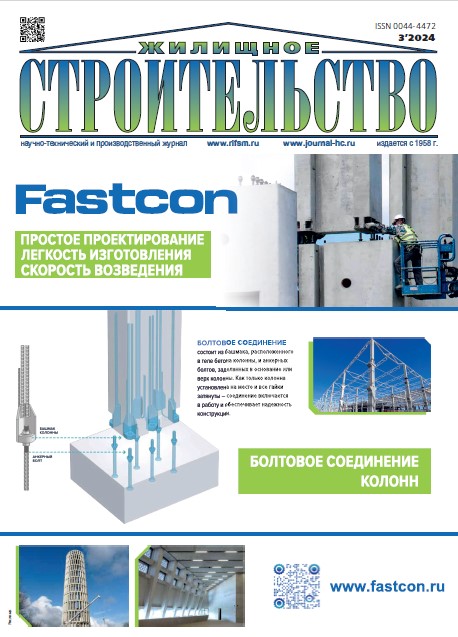Shallow Foundation With a Modified Shape of the Base
- Авторлар: Bay V.F.1, Safaryan V.S.1
-
Мекемелер:
- Tyumen Industrial University
- Шығарылым: № 3 (2024)
- Беттер: 52-56
- Бөлім: Articles
- URL: https://rjmseer.com/0044-4472/article/view/635704
- DOI: https://doi.org/10.31659/0044-4472-2024-3-52-56
- ID: 635704
Дәйексөз келтіру
Аннотация
The issue of optimizing the construction of shallow foundations is considered, due to the change of the base to a stepped one. Optimization involves reducing the cost of construction of a zero-cycle without losing the strength, reliability and durability of the object. The study was conducted in several stages, including numerical modeling, laboratory tests and field tests with foundation model. The simulation results showed that foundations with a flat base have a large shrinkage compared to foundations with a stepped base, varying from 6% to 28% depending on geological conditions and modeling techniques. Laboratory tests and a field experiment confirmed these results, showing that foundations with a stepped base have a lower draft relative to foundations with a flat base by at least 30%. In addition, stepped foundations turned out to be more resistant to random eccentricities and eccentric loading. The study makes it possible to assert that the use of foundations with the proposed geometry can lead to significant savings by reducing material and resource consumption, as well as provide additional load-bearing capacity. These conclusions can be useful in choosing the optimal type of foundation for objects with shallow foundations.
Негізгі сөздер
Толық мәтін
Авторлар туралы
V. Bay
Tyumen Industrial University
Хат алмасуға жауапты Автор.
Email: bay.vlad@yandex.ru
Candidate of Sciences (Engineering), Head of the Department of “Building structures”
Ресей, 38, Volodarskogo Street, Tyumen, 625000V. Safaryan
Tyumen Industrial University
Email: safaryanv@yandex.ru
Postgraduate Student
Ресей, 38, Volodarskogo Street, Tyumen, 625000Әдебиет тізімі
- Kyatov N.Kh., Kyatov R.N. Proektirovanie osnovanii i fundamentov [Design of bases and foundations]. Moscow: Yurait. 2023. 327 p.
- Bai V.F., Safaryan V.S. Improving the efficiency of shallow foundations. Arkhitektura, stroitel’stvo, transport. 2022. No. 1 (99), pp. 65–72. (In Russian). doi: 10.31660/2782-232X-2022-1-65-72
- Sokolov N.S., Sokolov S.N., Sokolov A.N. Fine-grained concrete as a structural building material of drilling piles ERT. Stroitel’nye Materialy [Construction Materials]. 2017. No. 5, pp. 16–19. (In Russian).
- Glushkov A.V., Glushkov V.E. Analysis of cruciform foundation bases based on ultimate strain. Vestnik of Volga State University of Technology. Materials. Constructions. Technologies. 2017. No. 1, pp. 39–46. (In Russian). EDN YIZHUP.
- Patent RF 2529977 C2. Fundament s vystupami po podoshve [Foundation with projections by foot portion]. Glushkov V.E., Bartolomei L.A., Glushkov A.V. Declared 01.02.2013. Published 10.10.2014. Bulletin № 28. (In Russian).
- Pronozin Ya.A., Naumkina Yu.V., Epifantseva L.R., Geidt L.V. Design model for strip shell foundation-soil interaction effects. Geotekhnika. 2016. No. 6, pp. 18–24. (In Russian). EDN XRFUEZ.
- Patent RF 2393297 C1. Fundament [Basement]. Pronozin Ya.A., Poroshin O.S., Epifantseva L.R., Naumkina Yu.V., Stepanov M.A. Declared 27.02.2012. Published 27.08.2013. Bulletin № 24. (In Russian).
- Hong T., Teng J. G., Luo Y.F. Axisymmetric shells and plates on tensionless elastic foundations. International Journal of Solids and Structures. 1999. Vol. 36. No. 34, pp. 5277–5300. doi: 10.1016/s0020-7683(98)00228-5
- Das B.M., Sobhan Kh. Principles of geotechnical engineering. Australia, Brazil, Japan, Korea, Mexico, Singapore, Spain, United Kingdom, United States: Cengage Learning. 2012. 756 p.
- Safaryan V.S. Freestanding foundation with stepped base. Results of a full-scale experiment. Arkhitektura, stroitel’stvo, transport. 2023. № 4 (106), pp. 17–25. (In Russian). doi: 10.31660/2782-232X-2023-4-17-25
- Gritsuk M.S. Rational design of plates for strip foundations. Doctor Diss. (Engineering). Brest. 1998. 283 p. (In Russian).
- Sokolov R.V., Dorofeeva O.S. Development of non-traditional forms of resource-saving foundations. Education: professional debut: Collection of materials of the VII International Student Scientific and Practical Conference. Kumertau. 2021. pp. 236–241. (In Russian). EDN VDWHBS.
- Rybin V.S., Rybina L.V. Determination of optimal shape and dimensions of the lower surface of eccentrically loaded shallow foundations. Osnovaniya, fundamenty i mekhanika gruntov. 2012. No. 1, pp. 6–9. (In Russian).
Қосымша файлдар













